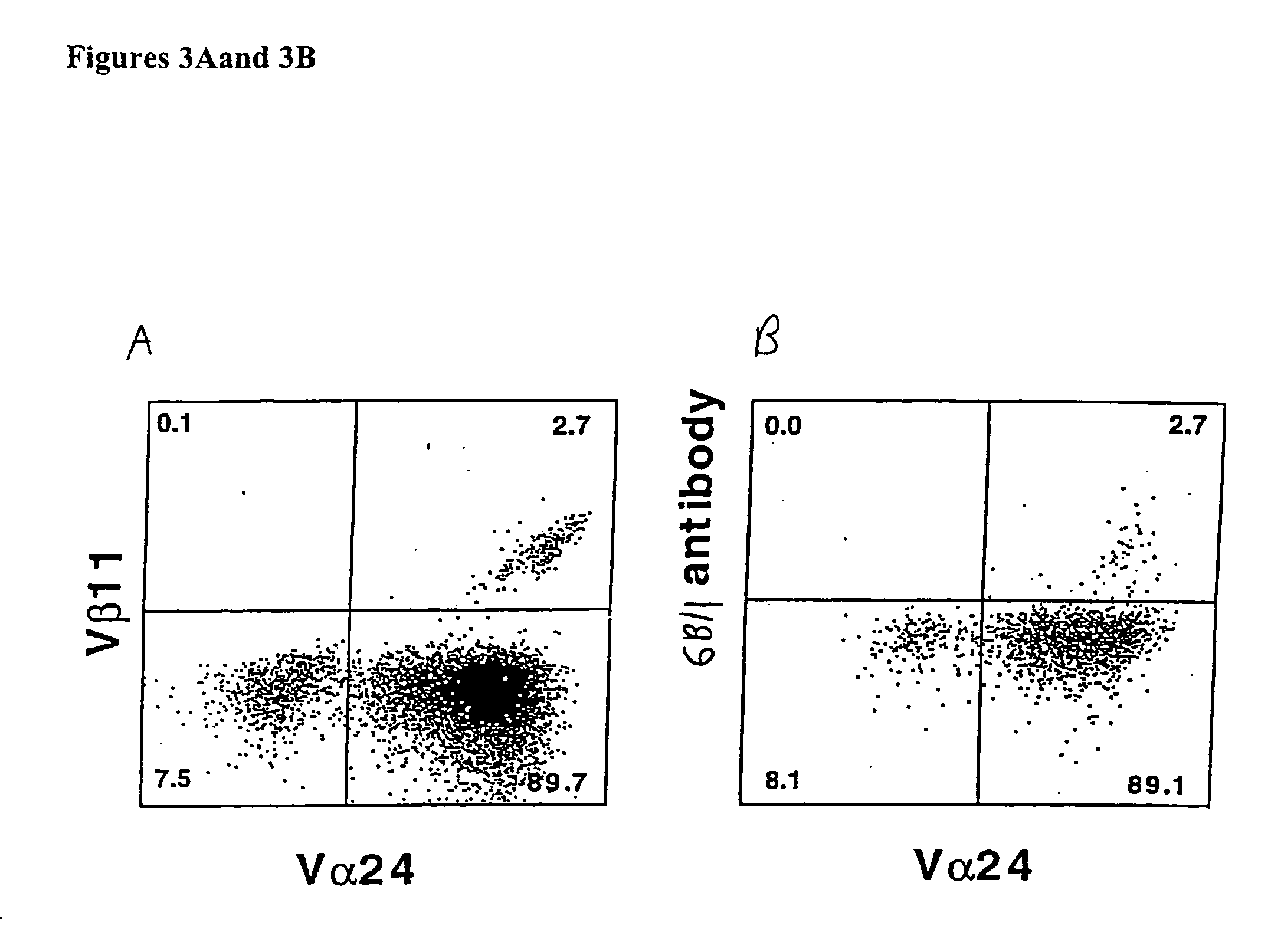Compositions and methods of monoclonal and polyclonal antibodies specific for T cell subpopulations
a technology of t cell subpopulation and polyclonal antibodies, which is applied in the field of compositions and methods of monoclonal and polyclonal antibodies specific for t cell subpopulations to achieve the effects of increasing the size of a subpopulation of t cells, and increasing the number of t cells
- Summary
- Abstract
- Description
- Claims
- Application Information
AI Technical Summary
Benefits of technology
Problems solved by technology
Method used
Image
Examples
example 1
Generation of Antibodies to a Human NK T Cell Antigen Receptor Alpha Chain
[0132]Because all invariant TCR+ T cells from all individuals have the same amino acid sequence in the CDR3 loop, this region was used in the design of peptides for the generation of anti-CDR3-loop antibodies. Because the murine and human sequence of the CDR3 loop are nearly identical (CVVSDRGST and CVVGDRGSA; SEQ ID NOs 2 and 3, respectively), a peptide with the human CDR3 loop sequence that is administered to mice might be recognized by the murine immune system as a self peptide and thus not induce the production of antibodies.
[0133]To overcome this potential problem, CD1d knockout mice (Sonoda et al., supra) which lack invariant TCR+ T cells were used as the host for the production of anti-CDR3-loop antibodies. Since these mice lack the invariant TCR-α chain they are able to recognize peptides containing the human CDR3 loop sequence as foreign, and thus, generate antibodies against this epitope.
[0134]For th...
example 2
Isolation and Expansion of Human Invariant T Cells with Monoclonal Antibody
[0141]FIG. 4 demonstrates that plate bound 6B11 monoclonal antibody can be used to achieve selective expansion of invariant T cells. Analysis of more than 20 clones and 15 lines derived from 15 healthy donors using 6B11 in this way has produced entirely consistent results: 100% of these were Vα24+ Vβ11+ CD161+, highly CD1d-reactive, high IL-4 producers, and modest IFN-γ producers (Table 2). This result further demonstrate the specificity of these monoclonal antibodies and their use as a more definitive and single color alternative that does not require autologous APCs, which would be undesirable in the setting of a clinical trial.
[0142]
TABLE 2Percentage of cell expressing invariant NK T cell markers and producing cytokinesafter expansion of T cell lines or T cell clones with the 6B11 antibody.DonorsCellsVα24+Vβ11+CD161+CD1d-reactiveIL-4IFN-γTcell1510-10010-10010-10010010010-100lines12Tcell2010010010010010065c...
example 3
Exemplary Methods for the Isolation and Expansion of T Cells of Interest
[0147]For the purification of a T cell subpopulation of interest, a positive and / or negative selection step may be performed. Examples of antibodies that may be used in a positive selection step include the 6B11, 3A6, anti-Vα24, anti-Vβ11, and anti-CD161 antibodies.
[0148]T cells of interest may also be enriched using a negative selection step that removes some of the undesired T cells or that removes other contaminants from a sample. For example, an anti-CD8 antibody and / or an anti-CD4 antibody may be used to enrich a sample for invariant NK T cells. A negative selection step may be performed prior to, concurrent with, or subsequent to a positive selection step.
[0149]A positive and / or negative selection step may be performed prior to or after a T cell expansion step. In one possible method, the T cells of interest are purified first and then selectively expanded. In another possible method, expanded T cells are ...
PUM
| Property | Measurement | Unit |
|---|---|---|
| high density | aaaaa | aaaaa |
| size | aaaaa | aaaaa |
| fluorescence | aaaaa | aaaaa |
Abstract
Description
Claims
Application Information
 Login to View More
Login to View More - R&D
- Intellectual Property
- Life Sciences
- Materials
- Tech Scout
- Unparalleled Data Quality
- Higher Quality Content
- 60% Fewer Hallucinations
Browse by: Latest US Patents, China's latest patents, Technical Efficacy Thesaurus, Application Domain, Technology Topic, Popular Technical Reports.
© 2025 PatSnap. All rights reserved.Legal|Privacy policy|Modern Slavery Act Transparency Statement|Sitemap|About US| Contact US: help@patsnap.com



